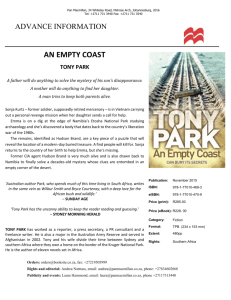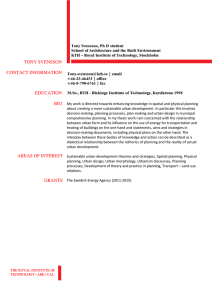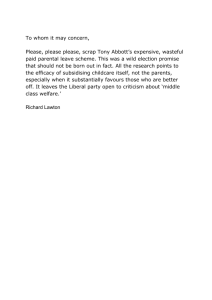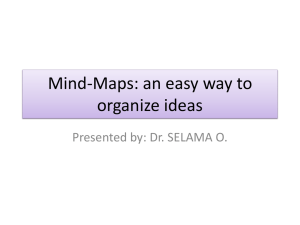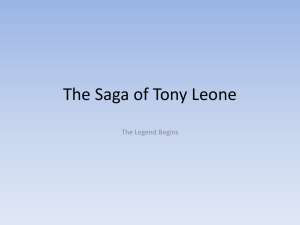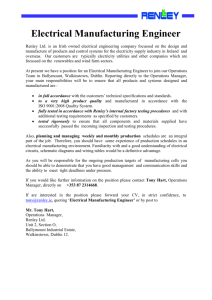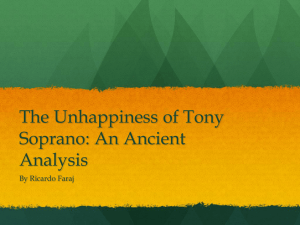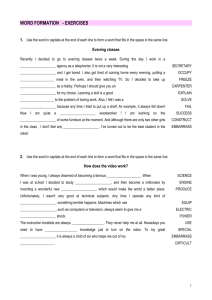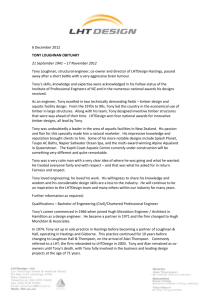A tribute to Tony - New Zealand Archaeological Association
advertisement
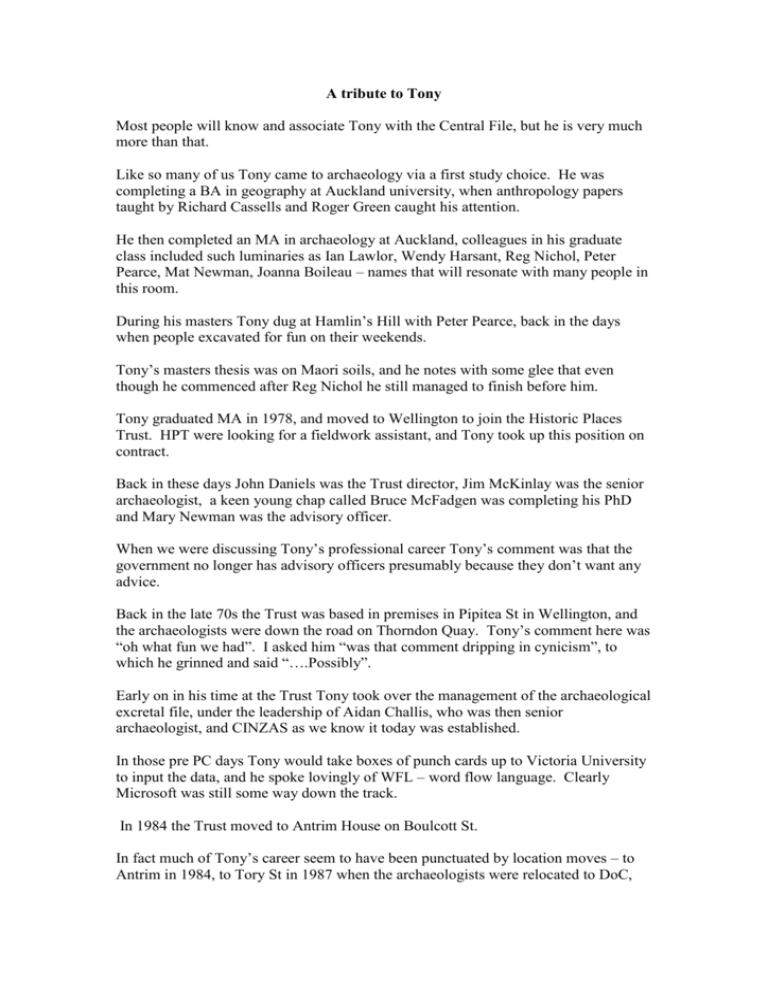
A tribute to Tony Most people will know and associate Tony with the Central File, but he is very much more than that. Like so many of us Tony came to archaeology via a first study choice. He was completing a BA in geography at Auckland university, when anthropology papers taught by Richard Cassells and Roger Green caught his attention. He then completed an MA in archaeology at Auckland, colleagues in his graduate class included such luminaries as Ian Lawlor, Wendy Harsant, Reg Nichol, Peter Pearce, Mat Newman, Joanna Boileau – names that will resonate with many people in this room. During his masters Tony dug at Hamlin’s Hill with Peter Pearce, back in the days when people excavated for fun on their weekends. Tony’s masters thesis was on Maori soils, and he notes with some glee that even though he commenced after Reg Nichol he still managed to finish before him. Tony graduated MA in 1978, and moved to Wellington to join the Historic Places Trust. HPT were looking for a fieldwork assistant, and Tony took up this position on contract. Back in these days John Daniels was the Trust director, Jim McKinlay was the senior archaeologist, a keen young chap called Bruce McFadgen was completing his PhD and Mary Newman was the advisory officer. When we were discussing Tony’s professional career Tony’s comment was that the government no longer has advisory officers presumably because they don’t want any advice. Back in the late 70s the Trust was based in premises in Pipitea St in Wellington, and the archaeologists were down the road on Thorndon Quay. Tony’s comment here was “oh what fun we had”. I asked him “was that comment dripping in cynicism”, to which he grinned and said “….Possibly”. Early on in his time at the Trust Tony took over the management of the archaeological excretal file, under the leadership of Aidan Challis, who was then senior archaeologist, and CINZAS as we know it today was established. In those pre PC days Tony would take boxes of punch cards up to Victoria University to input the data, and he spoke lovingly of WFL – word flow language. Clearly Microsoft was still some way down the track. In 1984 the Trust moved to Antrim House on Boulcott St. In fact much of Tony’s career seem to have been punctuated by location moves – to Antrim in 1984, to Tory St in 1987 when the archaeologists were relocated to DoC, then to Victoria St with DoC and finally to their current locale in Manners St. Unfortunately each move was marked by a loss of labs and space for archaeology. At the same time people came and went. Aidan replaced Jim as senior archaeologist and in turn the position was taken by Brian Sheppard. Mary Newman’s’ role was taken by Anne Geelen, and a bright young chap named Kevin Jones arrived to focus on forestry issue. Raewyn Sheppard was the archaeology assistant for some time, and in the late 80s I took the role for a couple of years, and was in turn replaced by Anne Williams. For about six months Tony would get confused between ann & I so hit on the thoroughly expedient solution of calling both of us MaryAnn, knowing that someone would answer. I also remember one of the map cabinets overbalancing one day and just about falling on Ann. Tony ran out to her screams and righted the cabinet and calmed Ann down. A few moments later his head poked out of his inner office with the deadpan comment “of course I was only worried about the maps”. Aidan told me his main memories of working with Tony in their HPT days were when they were sent on archaeological field work together - an investigation near Ahipara in 1978, a survey at Pouerua in 1992, and an investigation at Castle Hill in 1993. Aidan remarks of Tony “He is always a really effective practical and sensible person to work with and has great reserves of patience and endurance”. As well as managing CINZAS Tony undertook research and field-based archaeology. Bruce was undertaking his large project in the Bay of Plenty,. Tony assisted in setting the project up, and developing the fieldwork project. I was lucky enough to be involved in that, in fact its how I got my start in archaeology, and Tony notes that while we were traipsing round the mainland dealing with stroppy farmers he and Bruce were having a fabulous time surveying the BOP harbour islands – Rangiawea, Matakana, and Motiti. Tony has undertaken research into the archaeology of the Wanganui region, and he is the author of a concise but soon to be classic monograph on the archaeology of Taranaki/Wanganui. It summed up decades of interest in that region including continuing on Tony’s thesis topic of soils and gardening, the New Zealand Wars and archive-based work on Maori demography in the 1840s-1860s. Another research thread is military fortifications in New Zealand. In addition Tony has written on criteria for assessing archaeological significance, and also finalized Mary Newman’s Tongariro work and prepared it for publication. However it is probably for CINZAS that Tony is best known. I think we have just grown used to CINZAS and its functioning, and regard it with some complacence. Perhaps we need reminding that it is a complex database of about 59,497 records, and with data comprised of paper records, plans, maps and photos. But how often do we hear of problems with CINZAS? How often do we hear of cockups because of duplicate records or lost records or whatever? We don’t because Tony manages it to the highest possible standard. Most of you will be aware that I have babies at the database over the past few years when Tony was away on leave. When I first started I would send out data to colleagues with cheery gossipy e-mails until Tony did a remote logon to check the status and I received a terse message “less chat. More work”. Tony’s diligence with CINZAS has given us an utterly remarkable data set of profound rigour and robustness. Along with this Tony has developed an encyclopaedic knowledge of NZ archaeology. At Tory St I would get used to yelling out “Tone, who dug… or what date is..” and the reply would come back. It would only then dawn on me that he hadn’t had time to get up and look the data up. Tony has also been active in the Wellington Archaeological Society for decades, and his name is on many of the key site record forms for the Wellington region. I asked Kevin for thoughts on Tony, and he notes Tony has remarkable powers of concentration, reading and analysing issues. He can always be relied on for a dryly witty and well expressed contrary view. On Kevin Jones, for example, Tony says "On the rare occasions when he is right, he is very right". His recent work on a national study of pa produced, with Nicola Molloy, statistically sound results on pa, for example their size: average area 0.4 ha, perimeter 1438 m. With Kevin he also wrote a paper on the defences of Otatara. Kevin says that Tony is always a great help in interpreting aerial photographs, able to lend fresh insight to their analysis. He is difficult to get excited, being always very careful and professional, anything but long-winded. There was one occasion, though, when Vanessa Tanner brought him a vertical photo of a rectangular ditch and bank she had just noted, a possible redoubt, at Porangahau. Tony leaned over the pocket stereoscope, and produced the words slowly – “That.... is..... truly.... re..... mark.... able....”. A little-known fact about Tony is that he has a deep sense of social justice, being active in causes as diverse as Amnesty International and PSA work in DOC. He has also developed a deep knowledge and enjoyment of early-music performance up till about the era of Bach. Since his illness and his return to New Zealand, his colleagues have noted a change in his personality. He is very stoic in accepting his condition and responds well to black humour, he takes an even greater amusement than ever in the silliness of human behaviours, especially that of managers as a class, and he is better than ever at sardonic witticisms. Tony, you’re a good friend, a mentor, a critic, a scholar, a philosopher, devils advocate, a superlative archaeologist, and an NZAA taonga. Mary O’Keeffe
